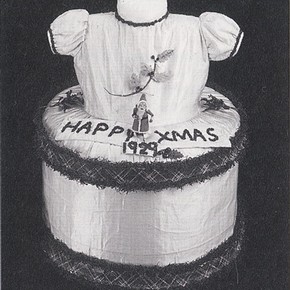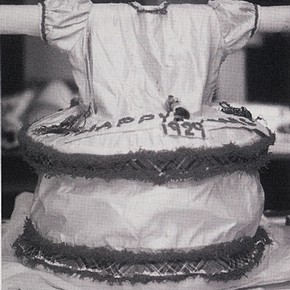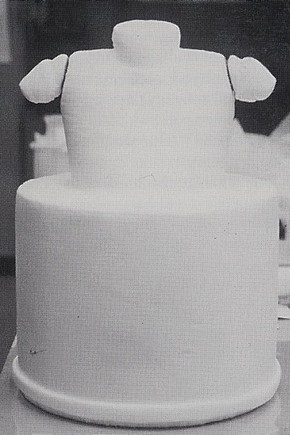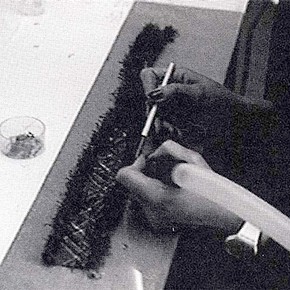Conservation Journal
January 1996 Issue 18
The Xmas Cake Dress
Throughout the eighteenth century, until about 1830, British painting was primarily concerned with portraiture. Artists and patrons felt that the portrait should not become unfashionable as time passed, so it became popular for a sitter to dress in 'fancy costume'. Foreign, rustic, classical or historical costume was chosen in order to give a timeless quality to the painting.
The dramatic effects achieved in this 'fancy portraiture' set fashions in the wearing of 'fancy dress' at balls. After the invention of photography, many notable persons had their likenesses taken wearing actual fancy dress that they had worn for an important ball. In the Scottish National Portrait Gallery, for example, is a photograph of HRH Alexandra, Princess of Wales dressed as Mary Queen of Scots as she appeared at the Waverley Ball in 1871. The costumes worn by fashionable persons at important balls were often described in the society section of Country Life and the Illustrated London News. Many costumes were commissioned from distinguished fashion houses of the day and it was reported that guests at the Devonshire House ball of 1897 were dressed by leading couturiers such as Worth and Paquin 1 . Theatrical costumiers also supplied 'fancy dress'. In 1839 L. and H. Nathan described their business as 'Masquerade Warehouse and Fancy Costume' and received the Royal appointment in 1888 in recognition of their services.
Costumes for children were also made by costumiers and dressmakers since juvenile fancy dress balls were also fashionable. The Sphere of 17 January 1914 shows photographs of 12 children dressed in fancy dress costumes worn to attend The Lord Mayor's Juvenile Fancy Dress Ball.
By the end of nineteenth century ideas were published in the form of fashion plates and books showing detailed design for 'fancy dress' for those who wished to make their own costumes. Most notable of these was 'Fancy Dress Described' by Arden Holt 2 . In the third edition, published in 1882, there is a special section devoted to 'Girls' and Boys' Fancy Dress Costume' offering a wide selection of ideas taken from fairy stories, characters from children's books, the natural world and seasonal subjects.

Fig. 1: The Xmas Cake Dress after conservation. Museum no. Misc. 172-1984 (click image for larger version)
Christmas is traditionally a time of parties, balls and other festivities and many fancy dress costumes were no doubt made for such occasions. One delightful example from the 1920s, a child's fancy dress in the form of a Christmas cake, has been acquired by the Museum (Fig. 1). The Xmas Cake Dress (Museum no. Misc. 172-1984) was purchased by the Bethnal Green Museum of Childhood in 1983 as part of a huge collection of costume, toys, books and other childhood material from a Miss Muriel Munro of Surrey. It is dated Christmas 1929 and was known to have been worn by her eldest sister Jean Munro when she was 7 years old. The complete outfit comprised the dress and hat, together with a silver coloured board and knife made of card as accessories. As a speciality piece of children's costume, and as an item of costume ephemera, the dress is a rarity and it is an object of great interest.
The dress bears no maker's label and is simply and crudely made indicating that it was likely to have been made at home, probably in a hurry. The dress and hat are made from a low quality, creamy-white mixed fibre satin weave fabric of cotton warp and silk weft. The bodice is simply cut with puffed sleeves. The skirt is gathered onto the bodice at the waist. Two light-weight wooden hoops wrapped around with cotton tape are stitched into the skirt to hold it out to make the shape of a round cake. The dress is trimmed with paper cake frills, gathered silk ribbons and artificial sprigs of holly and heather. There are four small Father Christmas figures stitched to the dress and 'Happy Xmas 1929' worked in gathered silk ribbon applied to bands of the creamy-white satin which are stitched onto the flat part on the top of the skirt. The hat is edged with a paper cake frill and decorated with sprigs of holly, two glass Christmas tree bells, two Father Christmas figures and a bird.

Fig. 2: The Xmas Cake Dress before conservation. Museum no. Misc. 172-1984 (click image for larger version)
The dress had been stored with the skirt collapsed and the fabric generally crushed. There was a film of grey dust over the surface of the fabric and trimmings. The exposed parts of the fabric had degraded, particularly on the bodice and sleeves which were extremely fragile and had split. The damage was worst on the shoulder areas which were the most exposed parts. Since the skirt had been stored collapsed and compressed, it had been protected from the dust and from light damage to some extent and was still in a clean and strong condition. The paper frills were crushed with the fringed edges compressed and the central tartan paper band torn in several places. The artificial flowers were also crushed, some of the leaves were detached and the wires were rusty and broken. The Father Christmas figure mounted on the front of the skirt had fallen over and the legs were only hanging on by a few threads of fibre stuffing (Fig. 2). The hat had also been stored flat. It was dusty and the trimmings were crushed but the satin fabric was sound.
Conservation
An important part of the conservation of this object was to devise a method whereby the costume could be prepared for display and for long term storage giving it full support, and making it unnecessary to manhandle the object each time it was needed to be shown or moved.
The advice of a paper conservator was sought before treating the paper cake frills which were in need of a great deal of consolidation in order to improve their condition and appearance. The papers used to make the cake frills were of cheap quality as they were not intended to last. Their colour was extremely fugitive and had left small red stains on the ground silk. They were fragile and needed to be relaxed, straightened, reshaped and extensively repaired.
The treatment strategy was as follows:
1. photograph the dress and hat to note condition and to show the precise positions of the decorative elements;
2. remove the surface dust;
3. remove the decorative elements and repair them;
4. conserve the ground silk where necessary;
5. take patterns and build permanent supports for the dress and hat;
6. re-attach the conserved decorative elements to the dress and hat;
7. place the completed objects on the purpose-made supports;
8. photograph the completed work as a way of monitoring the future condition when the objects are returned to the Bethnal Green Museum of Childhood.
A cardboard roller covered in acid free tissue was passed through the sleeves to take the weight of the dress across the shoulders. This was raised up and secured between two retort stands so that the dress could be lifted until the skirt was fully extended and the dress was at its full length. The surface was then lightly vacuumed using a vacuum tweezer unit to remove all the loose surface dust. Great care was taken particularly around the cake frills and the decorations which were then removed to be treated individually.
The dress was lightly steamed in order to relax the creases as far as possible and to assist with the removal of any distortions to the shape that had occurred during the long storage period.
It was decided to support the bodice and sleeves fully by lining them throughout using cream coloured silk Habotai. Couched (stitched) repairs to the damaged areas were carried out through to this support lining using fine polyester thread (SkalaTM , Gutermann). The fabric of the skirt was still in excellent condition although some hard creases still remained after the relaxation.
The dress could now be handled sufficiently to take a pattern from which to construct a support stand. Following a previously worked out method for the construction of hat supports 3 , the stand was made using card, curled and sculpted to shape and covered with polyester wadding, cotton lawn and then silk (Fig. 3; see also Note).
Attention was then turned to the decorative elements. The holly sprigs and heather sprigs had been crushed in storage and, in most cases, had broken wires and detached parts. These were disassembled and the rusty broken wires were replaced using fine floristry wire bound around or covered with fine Japanese Kozo paper which was held in place using wheat starch paste. Where berries or very small heather flowers needed reattachment, Mowilith 5OTM (Hoechst) in acetone was used as it gave an immediate and strong contact adhesion. Retouching to colour match was carried out after the repairs had been completed using water colour.
The red ribbon which had been gathered and used to decorate the neck edge had shredded and lost all tensile strength so, as it had to withstand the stress of being re-gathered for reattachment, it was decided to give it a dual method of support. Silk crepeline was dyed to colour match using LanasetTM(Ciba Geigy) dye and painted out onto polyethylene with a 20% solution of Mowilith DMC2TM (Hoechst), a poly(vinyl) acetate emulsion. When dry, this was heat set by ironing onto the back of the ribbon.
Working in the direction across the warp, the ribbon was then couched to the adhesive treated support using threads taken from StabiltexTM (Swiss Silk Bolting Cloth Manufacturing Co), a fine polyester thread. It was then possible to re-gather the ribbon and re-stitch it to the dress.
Minor repairs were undertaken to the Father Christmas figures and all loose parts were re-adhered using either wheat starch adhesive or Mowilith DMC2TM poly(vinyl) acetate emulsion, whichever seemed most suitable.
Finally the cake frills were treated (Fig. 4). These proved to be the most time consuming part of the work. Each frill was laid upon a MelinexTM (ICI) covered soft board and slowly and gradually humidified using an ultrasonic humidifier teasing out the fragile crushed paper fringing along its length. Great care had to be taken in the control of the moisture as the paper was extremely hygroscopic and the colour was very fugitive. Loose fragments were kept for reattachment. At the same time the central tartan band was also relaxed and straightened and any loose or torn parts of this were also kept.
The repair to the tartan band was carried out first using minute strips of Kozo paper behind each break, adhered with a fairly dry wheat starch paste. Any overhang of the support paper was trimmed back when the repair was dry. For repairs to the thin paper fringe a finer Kozo paper was pre-coloured to match using water colour then strips were cut and adhered using 5% IZlucel GTM (Hercules) in acetone. It was not possible to use an aqueous adhesive to repair this part of the paper fringe as it was too sensitive to moisture.
Once all the decorative elements had been repaired, each one was re-stitched onto the dress in its original place and the dress was lowered onto its stand. It had been necessary to make the supports for the puff sleeves as separate parts in order to allow the dress to be manoeuvred easily onto the stand. Once this had been accomplished the puff supports were slipped into the sleeves, located against the shoulder and secured using VelcroTM (Selectus) patches.
The conservation and support of the hat was then carried out following the same methods and principles used for the dress.
References
1.Stevenson, S. and Bennett, H., Van Dyke in Check Trousers, Fancy Dress in Art 1700- 1900, Scottish National Portrait Gallery, 1978.
2.Holt, A., Fancy Dress Described, or What to Wear at Fancy Dress Balls, Debenham and Freebody, 1882.
3.Kite, M., The Conservation of Three Straw Hats, The Conservator 15, 1991, pp.7-12.
Note
The conservation of this dress and the preparation of this support stand was carried out in 1992. Since that time further work has been undertaken on the preparation of full support stands and the author feels that, although the method described was most satisfactory, if it was to be done again today the stand would probably have been made from EthafoamTM (Dow), a polyethylene foam, carved to shape and finished with final coverings of cotton lawn and silk. A paper describing this more recent work was given at the ICOM-CC Textiles Working Group Interim Symposium held in Amsterdam in November 1994, and an article describing this work is at present in press in the Symposium Post-Prints due to be published by the end of 1995.
January 1996 Issue 18
- Editorial
- The Examination and Conservation of the Raphael Cartoons: an interim report
- Tarnishing of Silver: A Short Review
- The Xmas Cake Dress
- Review: Lining and Backing - The Support of Paintings, Paper and Textiles
- Student Summer Placements
- Summer Placement at the Canadian Museum of Civilisation
- Summer Placement at the Asian Art Museum of San Francisco
- Summer Placement at the Metropolitan Museum of Art

